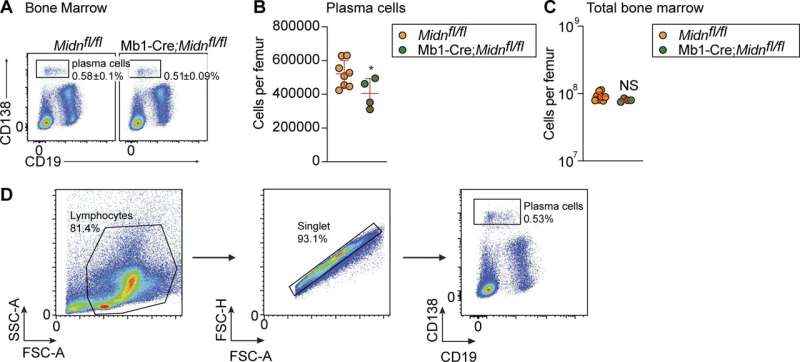This article has been reviewed according to Science X's editorial process and policies. Editors have highlighted the following attributes while ensuring the content's credibility:
fact-checked
peer-reviewed publication
trusted source
proofread
Researchers determine the mutations that protect mice from B-cell cancers

By completely or even partially depleting a protein called midnolin in B cells, UT Southwestern Medical Center researchers suppressed leukemia and lymphoma in a mouse model genetically prone to these cancers.
Their findings, reported in the Journal of Experimental Medicine, could lead to new treatments for these diseases that avoid the serious side effects of current therapies.
"We used a purely genetic method to find a drug target, and that target turns out to be sensational in that B-cell leukemias and lymphomas are strongly dependent on it, while most tissues of the host are not," said study leader Bruce Beutler, M.D., Director of the Center for the Genetics of Host Defense and Professor of Immunology and Internal Medicine at UT Southwestern.
Dr. Beutler, who shared the 2011 Nobel Prize in Physiology or Medicine for his discovery of an important family of pathogen sensors known as Toll-like receptors found on immune cells, has long used mutagenesis—introducing mutations into the genes of animal models through exposure to a chemical called N-ethyl-N-nitrosourea (ENU)—as a key tool for discovering the function of genes.
Recently, the Beutler Lab pioneered a method known as automated meiotic mapping (AMM) that traces unusual features in mutant mice to the causative mutations, thereby identifying genes needed to maintain the normal physiologic state.
Mutagenesis often causes genetic diseases to develop in animals, providing insight into the function of affected genes by studying the animals' abnormalities. However, Dr. Beutler explained, mutations can also provide protection from disease.
Examples include mutations that protect HIV-infected individuals, or those with inherited sickle cell disease, from developing symptoms. The mechanisms behind some protective mutations have inspired drugs to treat various health conditions.
Searching for protective mutations for immune disorders, the researchers screened mutant mice for those that had immune cells with unusual features. In multiple sets of animals with unusually low numbers of B cells—an important component of the adaptive immune system responsible for the production of antibodies—the researchers used AMM to trace this deficit to mutations in midnolin, a protein found primarily in B cells.
Although animals with complete absence of midnolin die during development before birth, milder mutations, including some introduced using a genetic technique that allows deletion of the gene during adulthood, caused no apparent harm.
The researchers significantly reduced or completely eliminated midnolin in mice genetically predisposed to B-cell leukemias and lymphomas, cancers in which B cells divide out of control. Although mice with normal midnolin died from these diseases by 5 months of age, most of those with less or no midnolin never developed the malignancies.
Additional experiments revealed that midnolin's role in B cells is to stimulate the activity of proteasomes, cellular organelles that dispose of proteins that are damaged or no longer useful. Some therapies currently used for B-cell leukemias and lymphomas work by inhibiting proteasome activity, much like ridding cells of midnolin does, explained Dr. Beutler.
However, unlike these drugs, which have numerous and potentially serious side effects, eliminating or reducing midnolin in animal models appeared to have no ill effects.
Future research will focus on developing midnolin-inhibiting drugs that could eventually serve as the basis for new B-cell cancer therapies.
More information: Xue Zhong et al, Viable mutations of mouse midnolin suppress B cell malignancies, Journal of Experimental Medicine (2024). DOI: 10.1084/jem.20232132

















